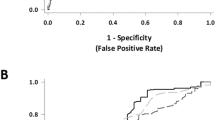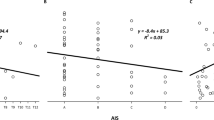Abstract
Study design
Multicentre, cross-sectional study.
Objectives
To determine if clinical measures of poor mental health (MH-) and neuropathic pain (NP) are related to increased CVD risk in individuals with chronic spinal cord injury (SCI), and further elucidate the relationships between CVD risk, autonomic function, NP, and MH-.
Setting
Eight SCI rehabilitation centres in the Netherlands.
Methods
Individuals (n = 257) with a traumatic, chronic (≥10 yrs) SCI, with age at injury between 18–35 years, completed a self-report questionnaire and a one-day visit to a rehabilitation centre for testing. CVD risk was calculated using Framingham risk score. NP was inferred using The Douleur Neuropathique 4 clinical examination, and MH- was assessed using the five-item Mental Health Inventory questionnaire. Cardiovascular autonomic function was determined from peak heart rate during maximal exercise (HRpeak).
Results
There was a high prevalence of both NP (39%) and MH- (45%) following SCI. MH- was significantly correlated with an adverse CVD risk profile (r = 0.174; p = 0.01), increased the odds of adverse 30-year CVD risk by 2.2 (CI 0.92–2.81, p = 0.02), and is an important variable in determining CVD risk (importance=0.74, p = 0.05). Females (p = 0.05) and those with a higher HRpeak (p = 0.046) tended to be more likely to have NP.
Conclusions
Clinical measures of MH-, but not NP, are important factors for increased CVD risk following SCI. NP tended to be more prevalent in those with more preserved cardiovascular autonomic function. The interrelationships between secondary consequences of SCI are complex and need further exploration.
This is a preview of subscription content, access via your institution
Access options
Subscribe to this journal
Receive 12 print issues and online access
$259.00 per year
only $21.58 per issue
Buy this article
- Purchase on Springer Link
- Instant access to full article PDF
Prices may be subject to local taxes which are calculated during checkout

Similar content being viewed by others
Data availability
The datasets generated and/or analysed during the current study are available from the corresponding author on reasonable request.
References
Burns S, Biering-Sørensen F, Donovan W, Graves D, Jha A, Johansen M, et al. International Standards for Neurological Classification of Spinal Cord Injury, Revised 2011. Top Spinal Cord Inj Rehabil. 2012;18:85–99.
Krassioukov A. Autonomic function following cervical spinal cord injury. Respir Physiol Neurobiol. 2009;169:157–64.
Furlan JC, Fehlings MG, Shannon P, Norenberg MD, Krassioukov AV. Descending Vasomotor Pathways in Humans: Correlation between Axonal Preservation and Cardiovascular Dysfunction after Spinal Cord Injury. J Neurotrauma [Internet]. 2003;20. Available from: www.liebertpub.com.
Claydon V, Krassioukov AV. Orthostatic Hypotension and Autonomic Pathways after Spinal Cord Injury. J Neurotrauma. 2006;23:1713–25.
Ravensbergen HJC, Post MWM, Slootman HJ, Claydon VE, van der Woude LHV, Groot S. Cardiovascular function after spinal cord injury: prevalence and progression of dysfunction during inpatient rehabilitation and 5 years following discharge. Neurorehabil Neural Repair. 2013;28:219–29.
Garshick E, Kelley A, Cohen SA, Garrison A, Tun CG, Gagnon D, et al. A prospective assessment of mortality in chronic spinal cord injury. Spinal Cord. 2005;43:408–16.
Cragg JJ, Stone JA, Krassioukov AV. Management of Cardiovascular Disease Risk Factors in Individuals with Chronic Spinal Cord Injury: An Evidence-Based Review. J Neurotrauma. 2012;29:1999–2012.
Dorton MC, Lucci VEM, de Groot S, Loughin TM, Cragg JJ, Kramer JK, et al. Evaluation of cardiovascular disease risk in individuals with chronic spinal cord injury. Spinal Cord. 2021;59:716–29.
Burke D, Fullen BM, Stokes D, Lennon O. Neuropathic pain prevalence following spinal cord injury: A systematic review and meta-analysis. Eur J Pain. 2017;21:29–44.
Williams R, Murray A. Prevalence of depression after spinal cord injury: A meta-analysis. Arch Phys Med Rehabil. 2015;96:133–40.
Cragg JJ, Noonan VK, Noreau L, Borisoff JF, Kramer JK. Neuropathic pain, depression, and cardiovascular disease: A national multicenter study. Neuroepidemiology. 2015;44:130–7.
Bouhassira D, Attal N, Alchaar H, Boureau F, Brochet B, Bruxell J, et al. Comparison of pain syndromes associated with nervous or somatic lesions and development of a new neuropathic pain diagnostic questionnaire (DN4). Pain. 2005;114:29–36.
Berwick DM, Murphy JM, Goldman PA, Ware JE, Barsky AJ, Weinstein MC. Performance of a Five-Item Mental Health Screening. Test. 1991;29:169–76.
Fayaz A, Ayis S, Panesar SS, Langford RM, Donaldson LJ. Assessing the relationship between chronic pain and cardiovascular disease: A systematic review and meta-analysis. Scand J Pain. 2016;13:76–90.
Oliveira CB, Maher CG, Franco MR, Kamper SJ, Williams CM, Silva FG, et al. Co-occurrence of Chronic Musculoskeletal Pain and Cardiovascular Diseases: A Systematic Review with Meta-Analysis. Pain Med. 2020;21:1106–21.
Siddall PJ, Mcclelland JM, Rutkowski SB, Cousins MJ. A longitudinal study of the prevalence and characteristics of pain in the first 5 years following spinal cord injury. Pain. 2003;103:249–57.
Davidoff G, Roth E, Guarracini M, Yarkony G, Sliwa J. Function-limiting dysesthetic pain syndrome among traumatic spinal cord injury patients: a cross-sectional study. Pain.1987;29:39–48.
Vall J, Mauricio C, Costa DC, Jesus T De, Santos T, Bovy S, et al. Neuropathic pain characteristics in patients from Curitiba (Brazil) with spinal cord injury. Arq Neuropsiquiatr. 2011;69:64–8.
Werhagen L, Budh CN, Hultling C, Molander C. Neuropathic pain after traumatic spinal cord injury – relations to gender, spinal level, completeness, and age at the time of injury. Spinal Cord. 2004;665–73.
Krassioukov AV, Bunge RP, Pucket WR, Bygrave MA. The changes in human spinal sympathetic preganglionic neurons after spinal cord injury. Spinal Cord. 1999;37:6–13.
Walters ET. How is chronic pain related to sympathetic dysfunction and autonomic dysreflexia following spinal cord injury? Auton Neurosc. 2018;209:79–89.
Alberto J, Manresa B, Susanne N, Finnerup B, Lauge I, Biering-sørensen F, et al. Central sensitization in spinal cord injured humans assessed by reflex receptive fields. Clin Neurophysiol. 2014;125:352–62.
Arnold JMO, Feng QP, Delaney GA, Teasell RW. Autonomic dysreflexia in tetraplegic patients: Evidence for α-adrenoceptor hyper-responsiveness. Clin Auton Res. 1995;5:267–70.
Saunders LL, Krause JS, Focht KL. A longitudinal study of depression in survivors of spinal cord injury. Spinal Cord. 2012;50:72–7.
Shao M, Lin X, Jiang D, Tian H, Xu Y, Wang L, et al. Depression and cardiovascular disease: Shared molecular mechanisms and clinical implications. Psychiatry Res. 2020;285:112802.
Cragg JJ, Noonan VK, Krassioukov A, Borisoff J. Cardiovascular disease and spinal cord injury: Results from a national population health survey. Neurology. 2013;81:723–8.
Adriaansen JJE, Van Asbeck FWA, Lindeman E, Van Der Woude LHV, De Groot S, Post MWM. Secondary health conditions in persons with a spinal cord injury for at least 10 years: Design of a comprehensive long-term cross-sectional study. Disabil Rehabil. 2013;35:1104–10.
Kong H, West S. WMA Declaration of Helsinki- Ethical Principles for Medical Research Involving Human Subjects. World Med Assoc. 2013;0:1–4.
West CR, Mills P, Krassioukov AV. Influence of the neurological level of spinal cord injury on cardiovascular outcomes in humans: a meta-analysis. Spinal Cord. 2012;50:484–92.
Rivera-Riquelme M, Piqueras JA, Cuijpers P. The Revised Mental Health Inventory-5 (MHI-5) as an ultra-brief screening measure of bidimensional mental health in children and adolescents. Psychiatry Res. 2019;274:247–53.
Van Leeuwen CMC, Van Der Woude LHV, Post MWM. Validity of the mental health subscale of the SF-36 in persons with spinal cord injury. Spinal Cord. 2012;50:707–10.
Ravensbergen HJR, Groot S, Post MW, Bongers-Janssen HM, Woude LH, Claydon VE. Is There an Association Between Markers of Cardiovascular Autonomic Dysfunction at Discharge From Rehabilitation and Participation 1 and 5 Years Later in Individuals With Spinal Cord Injury?. Arch Phys Med Rehabil. 2016;97:1431–9.
D’Agostino RB, Vasan RS, Pencina MJ, Wolf PA, Cobain M, Massaro JM, et al. General cardiovascular risk profile for use in primary care: The Framingham heart study. Circulation. 2008;117:743–53.
Pencina MJ, D’Agostino RB, Larson MG, Massaro JM, Vasan RS. Predicting the 30-year risk of cardiovascular disease: The framingham heart study. Circulation. 2009;119:3078–84.
Bucciarelli V, Caterino AL, Bianco F, Caputi CG, Salerni S, Sciomer S, et al. Depression and cardiovascular disease: The deep blue sea of women’s heart. Trends Cardiovasc Med. 2020;30:170–6.
Khandelwal A, Shafer LA, Ethans K. Does severity of spinal cord injury predict likelihood of suffering chronically from severe depression and anxiety? Spinal Cord Ser Cases. 2022;8:1–5.
Tate DG, Kalpakjian CZ, Forchheimer MB. Quality of life issues in individuals with spinal cord injury. Arch Phys Med Rehabil. 2002;83:18–25.
Cragg JJ, Warner FM, Shupler MS, Jutzeler CR, Cashman N, Whitehurst DGT, et al. Text Table 1 Interview questions for Survey on Living with Neurological Conditions in Canada (SLNCC). Heal Rep. Stat Can. 2018;29:11–6.
Werhagen L, Hultling C, Molander C. The prevalence of neuropathic pain after non-traumatic spinal cord lesion. Spinal Cord. 2007;45:609–15.
Lee SE, Greenough EK, Oancea P, Scheinfeld AR, Douglas AM, Gaudet AD. Sex differences in pain: Spinal cord injury in female and male mice elicits behaviors related to neuropathic pain. J Neurotrauma. 2023;40:833–844.
Adriaansen JJE, Douma-Haan Y, van Asbeck FWA, van Koppenhagen CF, de Groot S, van Asbeck FWA, et al. Prevalence of hypertension and associated risk factors in people with long-term spinal cord injury living in the Netherlands. Disabil Rehabil. 2017;39:919–27.
Acknowledgements
We are grateful to Dr. Vera-Ellen Lucci for her contribution to this work.
Funding
This study is part of the Dutch ALLRISC research program and is supported financially by ZonMw Rehabilitation program and Fonds NutsOhra, grant no. 89000006.
Author information
Authors and Affiliations
Contributions
JKK, MCD, and VEC conceived the idea for the study. MWMP and SDG designed the study protocol and collected the data. MCD and VEC analysed the data. JKK, MWMP, and SDG assisted in interpreting the results. MCD and VEC wrote the manuscript. VEC supervised the research. All authors contributed to the critical revision of the manuscript.
Corresponding author
Ethics declarations
Competing interests
The authors declare no competing interests.
Ethics
We certify that all applicable institutional and governmental regulations concerning the ethical use of human volunteers were followed during the course of this research.
Additional information
Publisher’s note Springer Nature remains neutral with regard to jurisdictional claims in published maps and institutional affiliations.
Rights and permissions
Springer Nature or its licensor (e.g. a society or other partner) holds exclusive rights to this article under a publishing agreement with the author(s) or other rightsholder(s); author self-archiving of the accepted manuscript version of this article is solely governed by the terms of such publishing agreement and applicable law.
About this article
Cite this article
Dorton, M.C., Kramer, J.K., de Groot, S. et al. Relationships between cardiovascular disease risk, neuropathic pain, mental health, and autonomic function in chronic spinal cord injury. Spinal Cord 61, 548–555 (2023). https://doi.org/10.1038/s41393-023-00933-y
Received:
Revised:
Accepted:
Published:
Issue Date:
DOI: https://doi.org/10.1038/s41393-023-00933-y



